I had some rather pallid silk embroidery thread. That bag it is sitting on came from an op shop and has been through eucalyptus dye pots so many times it is a very deep shade now!
I had some white and tan polwarth fleece.
Eucalyptus cinerea leaves… I have sacks of them and decided it was time to get them moving!
With wool going in a bit later…
Then a gift of E Nicholii leavea arrived from a fried whose keen eye and quick wits diverted council prunings from going directly to mulch. Thanks!
Here they are after some serious cooking.
My tour of the dye stash also uncovered these, sitting in a bag I used to use for gleaning the neighbourhood. Perhaps I could use it again if it wasn’t storing these leaves…
I thought I remembered them being unexciting. They are clearly ironbark leaves, but presumably I confused my ironbarks. I wasn’t sure and decided to try them out.
There has also been E Scoparia bark dyeing.
And here we have, fresh from the dye bath (a day later): E Nicholii at the top left; the unexciting ironbark, and E Scoparia bark at the bottom.
Later still, some of that polwarth fleece sitting on the piano like a fluffy flame…
First pass through the carder…
And now I have some thread with a bit more colour in it, too!


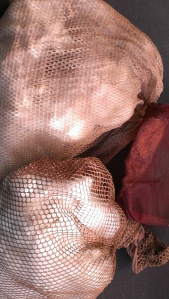
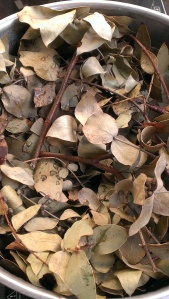


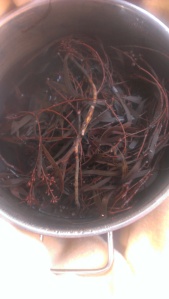
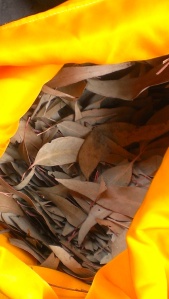
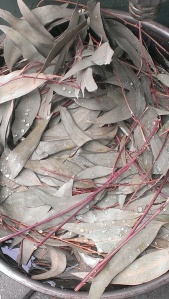
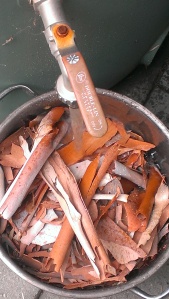
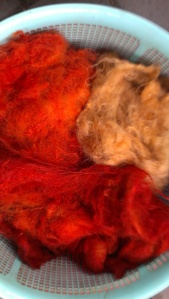

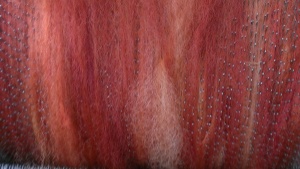
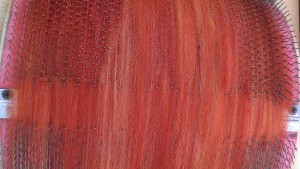
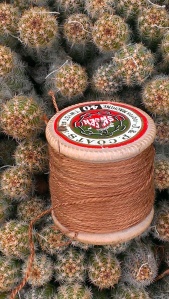
That IS a FLAME! Great, the bottom carded wool looks like Blood Oranges. nice.
LikeLike
Thanks, Susan! I have had dye pots running while I work today and I think there will be more good colour…
LikeLiked by 1 person
Wow, what a great colour xxx
LikeLike
Thankyou! I am looking forward to spinning this….
LikeLike
Here, far up in the North, we are going towards summer! After a cold spring the plants are finally coming up and the dyeing season can start.
LikeLike
Being on different sides of the world is amazing, isn’t it? I hope your growing and dyeing season goes really well!
LikeLike
What gorgeous colours!
LikeLike
l MUST be doing something wrong when l dye with Nicholii leaves! l never seem to get that red! Always a lovely dark orange, but never a red! Maybe the PH is wrong; l don’t know!
You put everything in the pot , right (leaves, buds,stems). l got told at Vic HW & Sp. not to put the sticks in, and definitely no alum! What pot are you using? Details, please!
LikeLike
I don’t think it is obvious you are doing anything wrong! Plants are diverse… grow in different places and soils and experience different temperatures, rainfall, growing circumstances. I perceive the colour I get from E Nicholii as orange rather than as red, though to be sure it is at the reddish end of orange! I do put everything in, yes (although the stems I put in are on the small side for manageability). Others do different things, and get different results: you might like to compare Jean Carman and the Victorian HSWG books with India Flint’s–human genius takes a lot of different forms and from time to time people get the way they do things mixed up with ‘the only way’. Reading a diversity of authors helps dispel this idea and so do texts that encourage and describe experimenting, like India Flint’s and Ida Grae’s Nature’s Colors: Dyes from Plants. Books that provide ‘recipes’ will teach you something different. I get different results from one bath to the next and stronger colours do tend to come from using a LOT of leaf relative to fibres. When dyeing wool I often would add an acid–like vinegar. I am using a stainless steel pot. I don’t use alum, there is no need. Bundle dyeing does give different results than dyeing in a vat the way most people would dye fleece… This bundle probably spent 6 hours in a dye bath one way or another but some of that time might have been steamier!
LikeLike